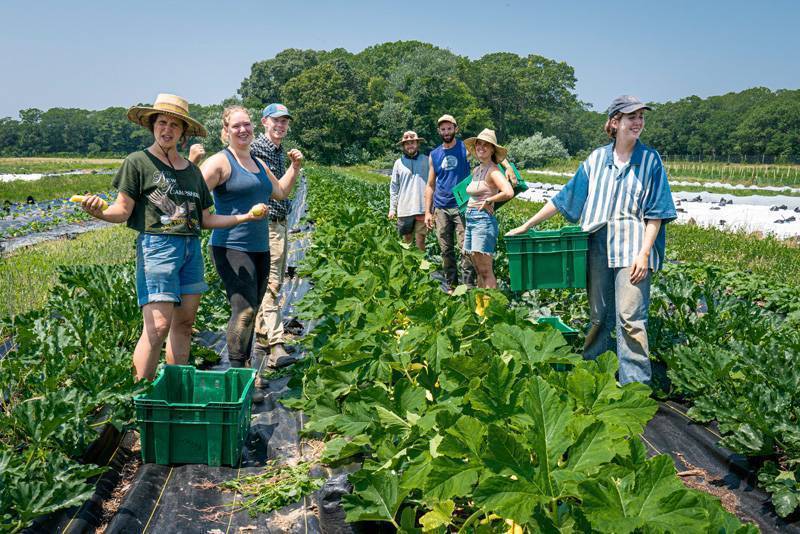To: Bluedot Living
From: Mary Sage Napolitano, IGI
Subject: Supporting native plants, insects, and wildlife at Island Grown Farm
While contemporary regenerative agriculture practices are largely focused on soil conservation and revitalization, farm landscapes are rich with opportunities for ecological restoration even beyond the cultivated fields. These open, often expansive landscapes can serve as unique support systems for certain native plants, insect species, and wildlife, to the mutual benefit of flora, fauna, and farmer. Most farms, including Island Grown Farm (IGF), have some marginal uncultivated areas that can be redesigned to enhance the regenerative potential of farm stewardship practices and on-farm biodiversity conservation at no loss to crop production or farm functioning. At Island Grown Farm, with the help of regional pollinator systems planner Evan Abramson, Matt Pelikan of Biodiversity Works, and the Fink Foundation, we’re undertaking a conversion of these spaces, a restoration from agricultural weeds and non-native grasses to native plant communities that can host, feed, and protect wild native and at-risk insect species and enrich the biodiversity of the farm system. (See Bluedot’s story, “Natural Neighbors” about doing this sort of thing in your own yard.)
Components of the farm-wide project include the hedgerows, herbaceous native field border plantings, and several larger meadow areas in uncultivated corners of the farm, all to be populated by plants known to support native insect pollinators. The meadows, currently dominated by cool-season pasture grasses, will be smothered over the summer and sown with native grasses and wildflowers in the fall, where seeds will stratify over winter and begin establishing next spring. These more expansive areas will serve as ‘habitat hubs’, perennial refuges for insects and birds, and also as founders’ plots, seed banks from which we can continue to collect seeds for establishing more plantings in the future. Within and adjacent to the farm fields, herbaceous flowering plants will be planted in field edges as pollen and nectar sources for native insect pollinator species, and draw those same species near to the crops that benefit from their assistance. Hedgerows, larger 8- to 12-foot-wide strips of woody native shrubs and understory plants, will be sited amongst the farm fields to bring protective cover, nesting habitat, and forage for insects and birds into the fields. Hedgerows also act as windbreaks in otherwise wide open agricultural lands, and can include native edible-fruit-producing shrubs such as blueberry, beachplum, huckleberry, and cranberry, which provide additional food yields while supporting native wildlife.
Enhancing the farm landscape with native plants has multiple benefits for the species they support, for the working farm system, and for the ecosystem as a whole. Permanent plantings in and around the fields of annual crops are also vegetated buffers, wherein deep-rooted plants improve water infiltration, take up excess soil nutrients, minimize runoff, and protect fragile nearby wetlands, surface waters, and the watershed at large. And while the plant palette is specifically designed for attracting and hosting known at-risk native pollinators, these habitats also host natural insect predators to common crop pests for integrated pest management, can help suppress weeds in field edge areas, and contribute to the dynamic ecological systems that make the farm so productive, diverse, and beautiful.
Also starting this year, a pilot project led by the Fink Foundation will create living labs at Island farms, in which blocks of pollinator-attracting plant species, including natives and several flowering plants commonly used on farms as cover crops, will be planted at participating farms. These plantings will be monitored by a team of citizen scientists, to collect data on which insects are visiting and/or pollinating which plants, so that we may continue to expand our understanding of how farms may best support our vulnerable insect populations, and how they may already be doing so with the the use of flowering cover crops. We’ve chosen a highly visible and accessible location for our pilot plot in the community garden at IGF, so visitors can see and learn from the project along with us as it unfolds.
This type of landscape restoration project requires an upfront investment of time, labor, and resources that can be challenging for farmers to commit to when the demands of the working farm are ample and financial margins are slim. In taking on this plan for enhancing biodiversity in our farmscape, we are developing a replicable model that can be shared with our community. Evan Abramson of Landscape Interactions will create a toolkit for implementing these strategies for enriching farm ecosystems and supporting wild pollinators on farms, driven by the specific ecological context of the Island, a first step that may ease some of the challenges to getting started for interested farmers and land stewards. Our plan, and the toolkit for executing it and similar projects Island-wide, will be completed this year, and we look forward to sharing it with our network of farmers, educators, and the community at-large this spring.
Sign up for IGI’s newsletter at the bottom of their home page.

